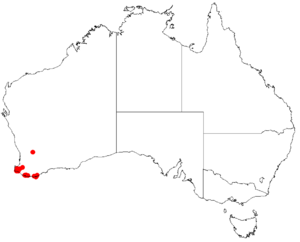Persoonia graminea facts for kids
Quick facts for kids Persoonia graminea |
|
|---|---|
 |
|
| Scientific classification | |
| Genus: |
Persoonia
|
| Species: |
graminea
|
 |
|
| Occurrence data from Australasian Virtual Herbarium | |
| Synonyms | |
|
Linkia graminea (R.Br.) Kuntze |
|
Persoonia graminea is a type of flowering plant. It belongs to the Proteaceae family, which includes many unique Australian plants. This plant is special because it is only found in the south-west part of Western Australia. It's a small shrub that can stand up straight or spread low to the ground. It has long, thin leaves and pretty flowers that grow in groups.
Contents
What it Looks Like
Persoonia graminea is a small shrub, usually growing between 20 and 60 centimeters (about 8 to 24 inches) tall. Its new branches are often covered with soft, greyish hairs.
Leaves and Flowers
The leaves of this plant are long and narrow, like blades of grass. They can be from 10 to 35 centimeters (about 4 to 14 inches) long and 2 to 8 millimeters (less than half an inch) wide. They usually grow in small bunches at the end of each year's new growth.
The flowers are bright yellow to green. They grow in groups of 10 to 25 along a stem called a rachis, which can be up to 22 centimeters (about 8.5 inches) long. Each flower has its own small stalk, called a pedicel. The flowering season for Persoonia graminea is from November to January. After flowering, the plant produces a small, oval-shaped fruit called a drupe. This fruit is about 4.5 to 6 millimeters long and contains one seed.
Plant Name and History
The scientific name Persoonia graminea was first officially written down in 1810. This was done by a famous botanist named Robert Brown. He described the plant in a scientific publication called Transactions of the Linnean Society of London. Robert Brown had collected samples of this plant back in December 1801 near King George Sound.
Where it Grows
This plant, sometimes called a "geebung," likes to grow in wet or loamy soils. You can find it in swamps, heathlands, woodlands, and forests. It typically grows within 40 kilometers (about 25 miles) of the coast. Its range stretches between the towns of Margaret River and Albany in Western Australia.
Is it Protected?
The Western Australian Government's Department of Parks and Wildlife has looked at Persoonia graminea. They have classified it as "not threatened." This means the plant is not currently in danger of disappearing.

